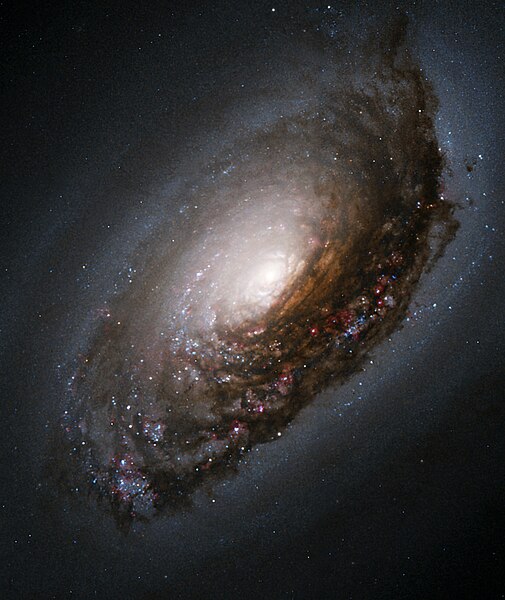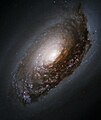Plaetje:Blackeyegalaxy.jpg

Gruutde van dees veurvertuining: 505 × 600 pixels. Anger resoluties: 202 × 240 pixels | 404 × 480 pixels | 897 × 1.065 pixels.
Oearsprunkelik bestandj ((897 × 1.065 pixel, besjtandsgruutde: 774 kB, MIME type: image/jpeg))
Besjtandshistorie
Klik op 'ne datum/tied óm 't besjtand te zeen wie 't oetzaog op det tiedsjtip.
| Datum/Tied | Miniatuurplaetje | Aafmaetinge | Gebroeker | Kómmentaar | |
|---|---|---|---|---|---|
| hujig | 2 jun 2005 11:46 |  | 897 × 1.065 (774 kB) | CWitte | This image of M64 was taken with Hubble's Wide Field Planetary Camera 2 (WFPC2). The color image is a composite prepared by the Hubble Heritage Team from pictures taken through four different color filters. These filters isolate blue and near-infrared lig |
Plaetjesverwiezinge
Dit plaetje weurt op de volgende pazjena's gebroek:
Globaal besjtandjsgebroek
De volgende anger wiki's gebroeke dit bestandj:
- Gebroek in af.wikipedia.org
- Gebroek in ar.wikipedia.org
- Gebroek in ast.wikipedia.org
- Gebroek in az.wikipedia.org
- Gebroek in be.wikipedia.org
- Gebroek in bg.wikipedia.org
- Gebroek in bn.wikipedia.org
- Gebroek in br.wikipedia.org
- Gebroek in bs.wikipedia.org
- Gebroek in ca.wikipedia.org
- Gebroek in ce.wikipedia.org
- Gebroek in ckb.wikipedia.org
- Gebroek in co.wikipedia.org
- Gebroek in cs.wikipedia.org
- Gebroek in cy.wikipedia.org
- Gebroek in de.wikipedia.org
- Gebroek in diq.wikipedia.org
- Gebroek in el.wikipedia.org
- Gebroek in en.wikipedia.org
- Messier object
- Coma Berenices
- List of galaxies
- Portal:Astronomy/Picture/May 2005
- Portal:Astronomy/Picture/12 May 2005
- Portal:Astronomy/Picture/Week 48 2005
- User:ComaDivine
- User:Superfo
- User:Gilgamesh~enwiki/Favorite images
- List of spiral galaxies
- Portal:Solar System
- Portal:Solar System/WikiProjects
- User:Passargea/Favourite pictures/Space
- User:Logos/Hall of Galaxies
- User talk:Example/Archives/2008/April
- User:Mike YuHong Chen
- User:Stefania.deluca/sandbox
Bekiek wikiwied gebroek van dit bestandj.
